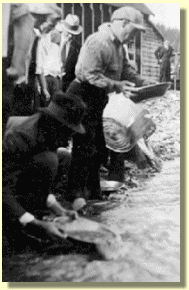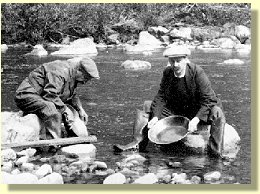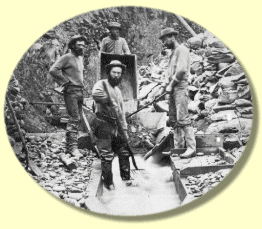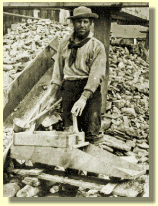Placer Mining Methods

|
|
Panning for Gold on William's Creek (BC Archives: D-04509) |
Placer Mining Methods
Placer means a deposit of gravel which contains particles of gold deposits. The word placer was derived from the Spanish word meaning "sand bank."
Since 1858, the recorded placer gold production in British Columbia has amounted to nearly $100,000,000. Of this total, almost half was pulled out of the creeks and rivers of the famous Cariboo.
During the first stage of gold mining, deposits in riverbeds were worked extensively. Miners would divert streams, sending smaller streams off to each side, leaving stream beds exposed. The dry conditions of summer and early fall were ideal as low water levels exposed areas where gold was hiding.
Methods such as gold panning, sluicing, and use of the rocker, were common forms of placer mining during this first stage.
Gold Panning

|
|
Panning for Gold on the Fraser (BC Archives: A-06395) |
The gold pan is one the oldest and simplest tools used to find gold. A shovelful of dirt and gravel would be dumped into the pan. The pan would then be lowered into the water and gently moved in circles. Large stones in the pan would be thrown out, and the dirt broken up using the miner's fingers. As the pan moved in circles, muddy water and sand would float out of the pan, with the much heavier gold remaining at the bottom of the pan.

|
| Sluicing a Claim on Grouse Creek (BC Archives: A-00351) |
The Sluice
The sluice-box, a long open wooden trough, was introduced and became very popular. The sluice is narrow and low at one end. Dirt and gravel is placed at the top and washed down the length of the sluice by a constant stream of water, usually from a flume. Gold would be caught either by "riffles" (ridges on the bottom of the sluice box) or by a false bottom with holes in it. Mud and the larger chunks of rock would wash out the lower end leaving the gold behind.
The Rocker
A rocker, also called a "cradle" or a "dolly", is used when water is in short supply or when the depth of the stream or creek is too shallow to use a sluice-box.

|
|
Hand Rocker at the Caledonia Claim (BC Archives: A-00353) |
The principle of the rocker is simple: As the cradle is rocked, water washes the finer material through the bottom of the hopper and gold collects on ridges or riffles.
Rockers were used extensively for placer mining. With one man to load soil and water and a second to rock it, the rocker could process about 200 bucketful's per day.



|
Last updated November 30, 1998. Produced by Steven Davies and the Schoolnet Digital Collections Team. |

|
